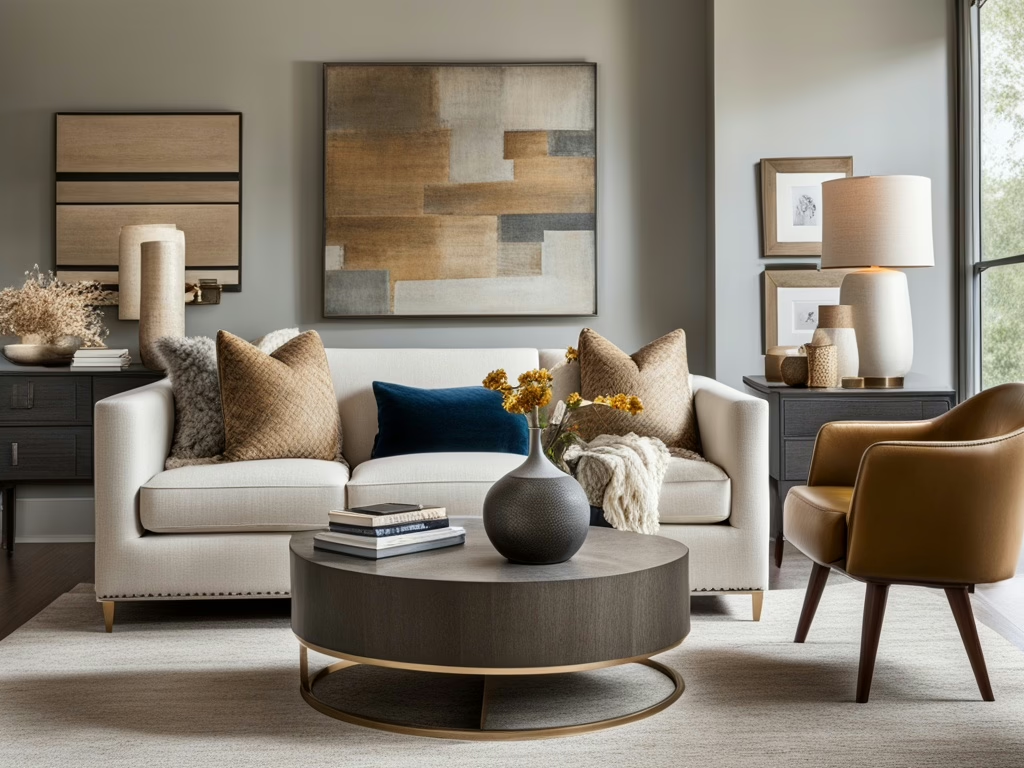
Why Accessorizing is Essential in Interior Design
Accessories are the final layer that transforms a space from ordinary to extraordinary. The rules of accessorizing help interior designers and home stagers create balance, personality, and cohesion in a room. Without proper accessorizing, even the most well-designed space can feel incomplete.
By following these expert accessorizing techniques, you can elevate a space effortlessly while maintaining functionality and aesthetic appeal.
1. Start with a Strong Foundation
Before adding accessories, ensure the base of your design is cohesive. Consider:
- Color Palette – Accessories should complement the existing color scheme.
- Furniture Scale & Layout – Accessories should enhance, not overwhelm, the space.
- Theme or Style – A clear design theme helps guide accessory choices.
Once these foundational elements are set, layering accessories becomes more intentional and impactful.
2. Follow the Rule of Three
One of the most fundamental rules of accessorizing is the Rule of Three, which creates a visually appealing balance. When styling:
- Group items in odd numbers – Three or five items create a more dynamic arrangement than even numbers.
- Vary heights and textures – Combine tall, medium, and small objects for a natural flow.
- Use a unifying element – Whether through color, material, or shape, accessories should share a common thread.
This rule works well for coffee tables, shelves, and entryway consoles, ensuring accessories feel curated rather than cluttered.
3. Mix Textures and Materials
Adding a variety of materials and textures enhances depth and interest. When applying the rules of accessorizing, consider combining:
- Soft elements – Throw blankets, plush pillows, or linen curtains.
- Natural materials – Wood, stone, woven baskets, or plants.
- Reflective surfaces – Metallic finishes, mirrors, and glass accents.
A well-balanced mix prevents the space from feeling flat or one-dimensional.
4. Incorporate Functional Accessories
Accessories should be both beautiful and practical. When staging or designing a space, choose pieces that serve a purpose:
- Decorative trays – Keep surfaces organized while adding a polished look.
- Baskets and storage boxes – Provide a stylish solution for clutter.
- Books and magazines – Offer both décor and entertainment.
Well-chosen accessories should enhance the usability of a space while maintaining an intentional aesthetic.
5. Layer Lighting for Ambiance
Lighting is one of the most overlooked but essential elements in accessorizing. A well-lit space should have:
- Ambient lighting – Overhead fixtures or recessed lighting.
- Task lighting – Desk lamps, reading lights, or under-cabinet lighting.
- Accent lighting – Wall sconces, LED strip lights, or decorative table lamps.
By layering different light sources, designers can highlight key accessories and create an inviting atmosphere.
6. Use Mirrors to Enhance Space & Light
Mirrors are a go-to accessory in interior design and staging. When strategically placed, they can:
- Reflect natural light, making rooms appear brighter.
- Create the illusion of more space in small areas.
- Serve as a statement piece, adding elegance and depth.
For best results, place mirrors across from windows or behind focal points like a dining table or entryway console.
7. Avoid Over-Accessorizing
While accessories add personality, too many can create clutter. Follow these decluttering principles:
- Edit frequently – Rotate accessories seasonally for a refreshed look.
- Leave negative space – Not every surface needs décor.
- Let statement pieces shine – If an accessory is bold, let it be the focal point.
Quality over quantity ensures that each accessory adds value rather than visual noise.
8. Personalize with Art & Meaningful Pieces
Adding personal elements creates a lived-in, welcoming feel. Art, family heirlooms, or travel souvenirs tell a story and add authenticity. When incorporating art:
- Match scale to space – Large walls need statement pieces, while smaller ones benefit from grouped collections.
- Balance frame styles – Mixing modern and vintage frames adds depth.
- Create gallery walls – A well-curated gallery wall makes a powerful impact.
Personalized accessories make a home feel intentional and tailored to its occupants.
Transform Spaces with Thoughtful Accessorizing
Mastering the rules of accessorizing allows designers and home stagers to create spaces that feel complete, stylish, and inviting. By following these principles, you can enhance any room with minimal effort.
Ready to Elevate Your Design Skills?
If you’re passionate about perfecting interiors and learning expert staging techniques, it’s time to take your career to the next level!
🔗 Join Our Private Facebook Group: The Interior Design/Home Staging Business Incubator
🔗 Expand Your Expertise: The Academy of Home Staging & Design
Turn your love for design into a thriving business—start today! 🚀